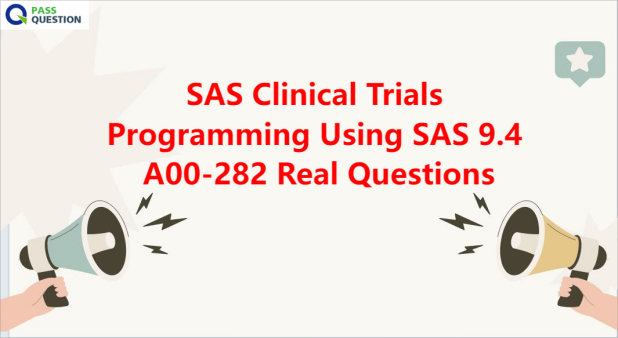SAS Clinical Trials Programming Using SAS 9.4 A00-282 Real Questions
Are you fully prepared to pass the A00-282 SAS Certified Professional: Clinical Trials Programming Using SAS 9.4 exam? At PassQuestion, we offer the latest and most comprehensive SAS Clinical Trials Programming Using SAS 9.4 A00-282 Real Questions that are designed to encompass all the objectives and core topics of the exam, ensuring you have a thorough understanding of the material. Our aim is to give you the confidence and knowledge to pass your exam with ease. We are confident that these SAS Clinical Trials Programming Using SAS 9.4 A00-282 Real Questions will be instrumental in helping you navigate through the complexities of the exam and ultimately achieve your goal.

SAS Certified Professional: Clinical Trials Programming Using SAS 9.4
This credential is a Professional-level credential and requires that you:
- Hold the Base Programming Specialist OR the Advanced Programming Professional.
- Take and pass the A00-282 Clinical Trials Programming Using SAS 9.4 exam.
You should Master the following skills to earn a certification.
- Demonstrate knowledge of the clinical trials process and data structures.
- Access, manage and transform clinical trials data.
- Apply statistical procedures to analyze clinical trials data.
- Utilize macro programming for clinical trials data.
- Report clinical trials results.
- Validate clinical trials data reporting.
Exam Details
Name: SAS Certified Professional: Clinical Trials Programming Using SAS 9.4
Exam Code: A00-282
This exam is administered by SAS and Pearson VUE.
60-70 multiple-choice and short answer questions.
Must achieve a score of 68% correct to pass.
1 hour 50 minutes to complete exam.
Exam Content
The following objectives will be tested on the exam. For more information about each objective, download the complete exam content guide.
5% - Clinical Trials Process
10% - Clinical Trials Data Structures
5% - Regulatory Submissions
5% - Manage Clinical Trials Data
15% - Transform or Summarize Clinical Trials Data
15% - Apply Statistical Procedures for Clinical Trials
15% - Macro Programming for Clinical Trials
10% - Report Clinical Trials Results
20% - Validate Clinical Trial Data Reporting
View Online SAS Certified Professional: Clinical Trials Programming Using SAS 9.4 A00-282 Free Questions
1. What information can be found in the SAS Dictionary tables? There are two correct answer, Please select two correct answer.
A. datasets contained within a specified library
B. values contained within a specified format
C. variables contained within a specified dataset
D. values contained within a specified variable
Answer: A C
2. What is the primary purpose for specifying identifier variables across SDTM domains?
A. To uniquely reference each record
B. To satisfy regulatory conditions
C. To include the appropriate subject information
D. To include the appropriate study information
Answer: A
3. When writing a validation program using independent programming, which two actions conform to good programming practices? (Choose two.)
A. Ensure the production program has been run prior to compare.
B. Delete subjects from the production side that are causing differences with the validation data set.
C. Copy statistical code directly from the SAP.
D. Copy statistical code directly from the production program.
Answer: A C
4. What is the key to ensuring traceability across CDISC data sets and modes?
A. Including STDM variables used to derive ADaM variables in the ADaM data set.
B. Creating a map for each variable to all of its related predecessors.
C. Establishing a clear path between an element and all of its immediate predecessors.
D. Establishing a clear path between an element and all of its immediate successors.
Answer: A
5. You have been asked to import an Excel spreadsheet.
What will lead to substantial differences between the original Excel spreadsheet and the resulting SAS data set?
A. the number of rows to be read from the Excel file
B. the number of columns to be read from the Excel file
C. multiple value types within a single column
D. multiple value types within a single row
Answer: C
6. Which of these tasks is NOT required for a validating programmer to state that an output has been independently validated using double programming once a PROC COMPARE has been run and shows the output electronically validates?
A. The Statistical Analysis Plan has been approved and signed off by the sponsor.
B. The output is using the correct title specified in the Statistical Analysis Plan.
C. Counts displayed in the columns are coherent.
D. The output is correctly paginated.
Answer: A
7. Which statement describes an aspect of all Phase II clinical trials?
A. randomized controlled multicenter trials on large patient groups
B. designed to assess the pharmacovigilance, pharmacokinetics, and pharmacodynamics of a drug
C. in vitro and in vivo experiments using wide-ranging doses of the drug
D. designed to assess how well the drug works and further assess safety
Answer: D
8. What is the primary purpose of programming validation?
A. Ensure that the output from both the original program and the validation program match.
B. Efficiently ensure any logic errors are discovered early in the programming process.
C. Justify the means used to accomplish the outcome of a program and ensure its accurate representation of the original data.
D. Document all specifications pertaining to programmed output and ensure all were reviewed during the programming process.
Answer: C
9. Which two features are captured by the events general observation class of SDTM? (Choose two.)
A. Investigational or therapeutic treatments
B. Planned protocol milestones
C. Planned evaluations
D. Subject characteristics
Answer: B C
10. What is the main focus of Good Clinical Practices (GCP)?
A. harmonized data collection
B. standard analysis practices
C. protection of subjects
D. standard monitoring practices
Answer: C
- TOP 50 Exam Questions
-
Exam
All copyrights reserved 2025 PassQuestion NETWORK CO.,LIMITED. All Rights Reserved.

